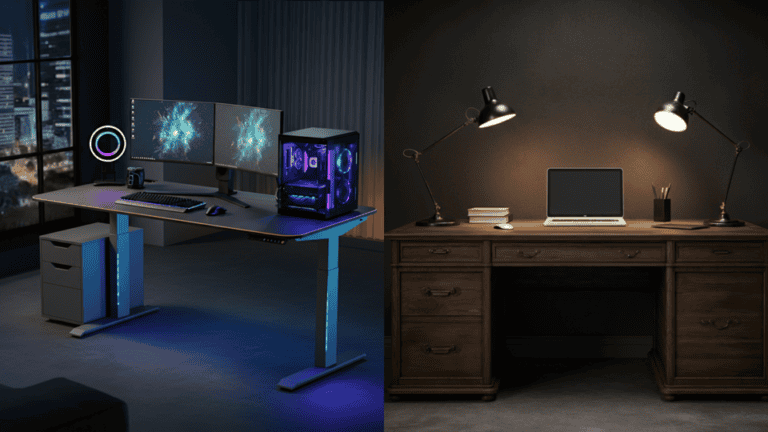Smart desks represent a revolutionary advancement in office furniture design, combining ergonomic features with cutting-edge technology to enhance workplace productivity. These innovative workstations go beyond simple height adjustability, incorporating features like preset memory settings, integrated technology, and health tracking capabilities. As businesses increasingly focus on optimizing employee performance, smart desks have emerged as a powerful tool for boosting productivity and improving overall workplace wellness.
The Science Behind Workplace Productivity
Numerous factors influence workplace productivity, including environmental conditions, ergonomics, and cognitive function. Research has shown that the physical workspace plays a crucial role in shaping employee performance and well-being. Ergonomic design principles, when applied to office furniture, can significantly reduce physical discomfort and mental fatigue, leading to improved focus and productivity.
Studies have demonstrated that the layout and features of a workspace can directly impact cognitive performance. For instance, designs that support both privacy and interaction can enhance cognitive functioning by reducing stress and fostering a sense of belonging. This underscores the importance of creating flexible, adaptable workspaces that cater to diverse work styles and preferences.
Smart Desk Features That Boost Productivity
Height Adjustability
One of the primary features of smart desks is their height adjustability, allowing users to seamlessly transition between sitting and standing positions. This flexibility can have a profound impact on focus and energy levels throughout the workday. By reducing physical discomfort and promoting movement, height-adjustable desks help maintain alertness and combat the negative effects of prolonged sitting.
Preset Memory Settings
Many smart desks come equipped with preset memory settings, enabling users to quickly switch between their preferred desk heights. This feature streamlines transitions and minimizes disruptions to workflow, contributing to increased efficiency and productivity.
Integrated Technology
Smart desks often incorporate built-in technology features such as charging ports, displays, and connectivity options. These integrations reduce clutter and streamline workspace organization, allowing employees to focus on their tasks without the distraction of tangled cords or insufficient power sources.
Health Tracking Capabilities
Some advanced smart desk models include health tracking features that monitor sitting and standing times, as well as other ergonomic factors. By providing users with real-time feedback on their work habits, these desks encourage healthier behaviors and can lead to improved long-term productivity.
Productivity Metrics and Smart Desks
Measuring workplace productivity often involves tracking metrics such as task completion rates, time management, and overall output quality. Smart desks can play a valuable role in collecting and analyzing productivity data, offering insights into work patterns and habits.
By examining smart desk usage patterns, businesses can gain a deeper understanding of how employees interact with their workspaces and identify opportunities for optimization. This data-driven approach allows for more informed decision-making regarding workspace design and productivity enhancement strategies.
Case Studies: Smart Desks in Action
Several companies have successfully implemented smart desks to boost productivity and employee satisfaction. For example, a large tech firm reported a 20% increase in overall productivity after introducing height-adjustable smart desks across their offices. Employees cited improved comfort, reduced fatigue, and enhanced focus as key benefits of the new workstations.
Another case study involving a marketing agency found that smart desk implementation led to a 15% reduction in reported back pain and a 10% increase in daily task completion rates. Employee feedback was overwhelmingly positive, with 87% of staff reporting higher job satisfaction after the transition to smart desks.
Optimizing Smart Desk Usage for Maximum Productivity
To maximize the benefits of smart desks, users should follow best practices for transitioning between sitting and standing positions. Experts recommend alternating between these positions every 30-60 minutes to maintain optimal comfort and focus. Integrating smart desk features into daily work routines, such as setting reminders for position changes or utilizing health tracking data, can further enhance productivity gains.
Combining smart desk usage with other productivity techniques, such as the Pomodoro method or time-blocking, can create a comprehensive approach to workplace efficiency. By leveraging the flexibility and features of smart desks in conjunction with proven productivity strategies, employees can optimize their work performance and overall well-being.
The Future of Smart Desks and Workplace Productivity
As technology continues to advance, the future of smart desks looks promising. Emerging technologies such as artificial intelligence and machine learning may soon be integrated into smart desk systems, offering personalized productivity recommendations based on individual work patterns and preferences.
Smart desks are likely to play an increasingly important role in future workplace design trends, as businesses prioritize flexible, adaptable spaces that cater to diverse work styles. The integration of smart desks with other smart office technologies, such as environmental controls and scheduling systems, may create holistic, interconnected workspaces that seamlessly adapt to employee needs.
Challenges and Considerations
While smart desks offer numerous benefits, there are potential drawbacks and limitations to consider. Initial implementation costs can be significant, and some employees may require time to adjust to new work habits. Additionally, data collection and privacy concerns must be addressed to ensure employee comfort and trust in smart desk technologies.
However, a cost-benefit analysis often reveals that the long-term productivity gains and health benefits of smart desks outweigh the initial investment. As the technology becomes more widespread and affordable, it is likely that smart desks will become increasingly common in workplaces across various industries.
Conclusion
Smart desks represent a significant advancement in workplace design, offering a powerful tool for enhancing productivity and employee well-being. By combining ergonomic principles with cutting-edge technology, these innovative workstations address many of the challenges associated with traditional office setups.
As research continues to demonstrate the positive impact of smart desks on workplace productivity, it is likely that their adoption will continue to grow. The long-term outlook for smart desks in enhancing workplace productivity is promising, with potential advancements in personalization and integration with other smart office technologies on the horizon. By embracing these innovative solutions, businesses can create more efficient, comfortable, and productive work environments for their employees.

